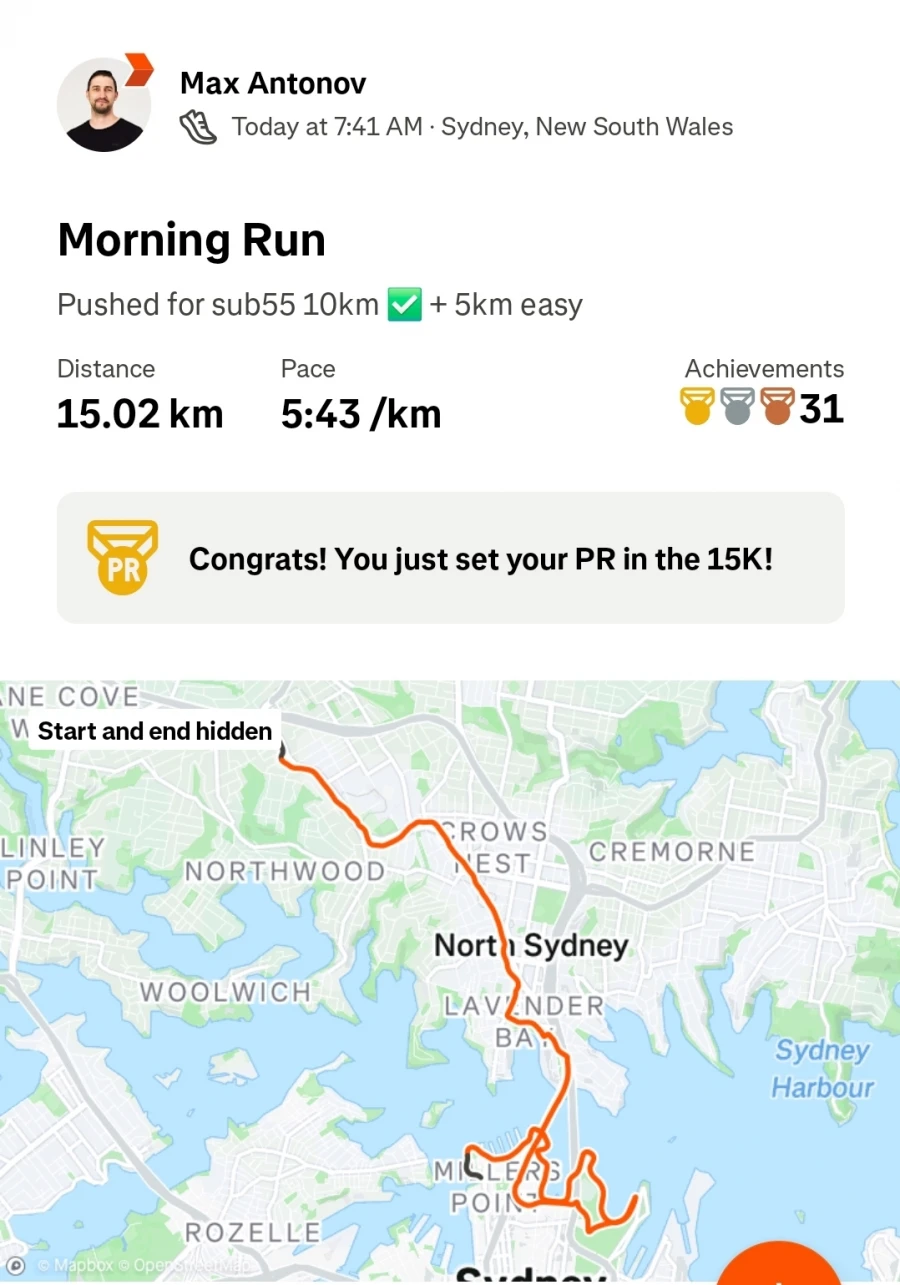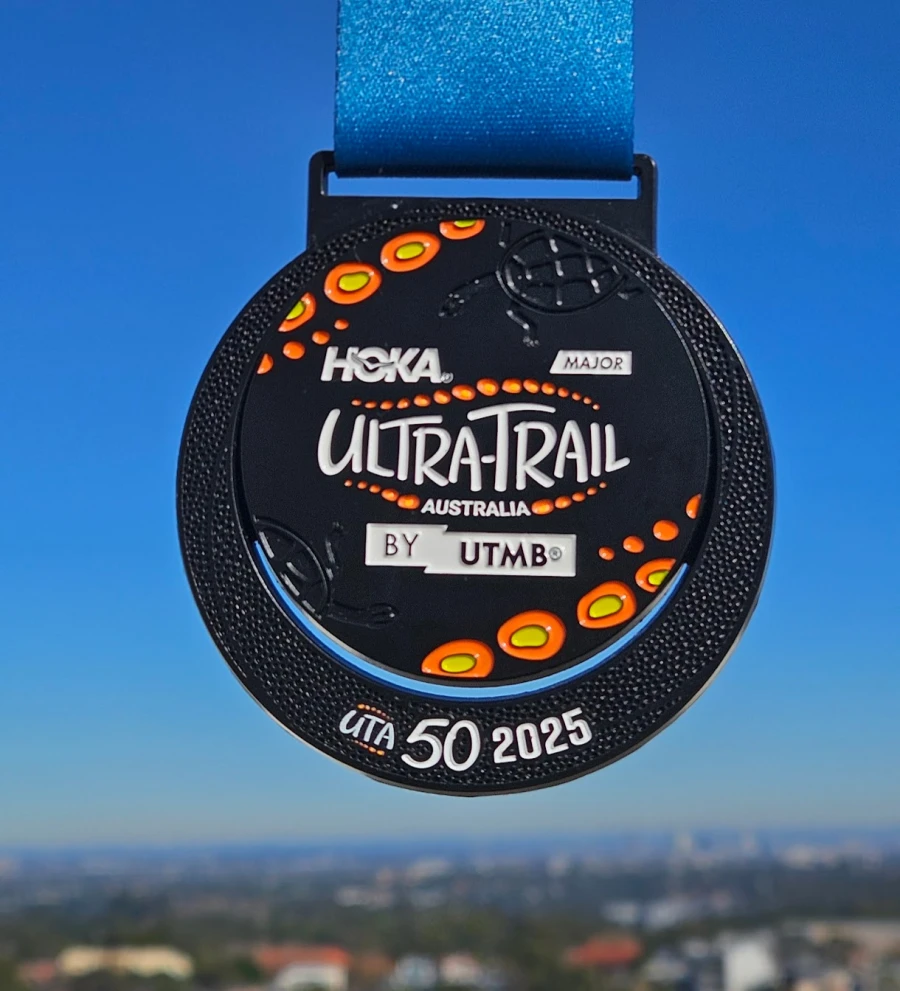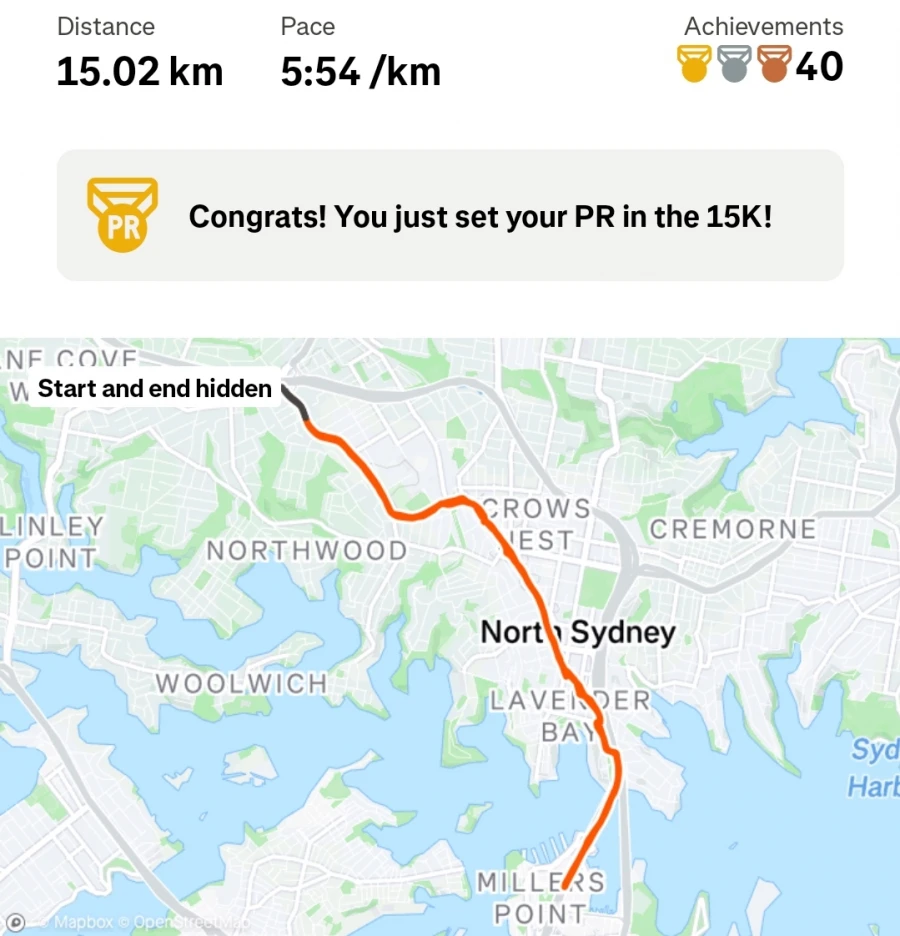-
Love your job. But don't let it eat your life.
Work gives you purpose, adrenaline and praise. But it also wants more. More time. More mindshare. More of you. And if you're good at it, even more will be asked.
Your energy is finite. Use it well. Set a time to log off and don't cheat it. Book your workouts like meetings. Put family time on the calendar and guard it like an investor call. Say no to evening slacks. Skip the weekend emails. Make space for life outside your inbox.
Work hard. Just don't forget who you're doing it for. -
Went for a run this morning - really enjoying getting out early on the weekend. The goal was to go sub-55 for 10km, then take it easy for the final 5km. I cooled down with a gentle pace, pushed a little at the end and ended up with a 15km PB as well.
Loving these runs across the Sydney Harbour Bridge. Stunning views - running past the Opera House, through the Botanic Gardens and finishing in Barangaroo. One of the best spots in the world ❤️

-
Love lunches with my team.
It's the sideways stories, the throwaway jokes, the unfiltered glimpses into who people really are.
You won't find those in meetings or sprint reviews. They happen over a sandwich. When the pressure's off. When people exhale.
Moments like that stay with you. -
Jun 24, 2025
The best PMs demand clarity. They don't rush ahead until the problem, the why and the how are nailed down. Then they spread it. With sharp words. With tight updates. With documents people actually read.
-
Jun 23, 2025
Over the weekend, I've been playing around with some Vibe Coding to tackle a challenge I've been thinking about.
There are probably existing products that do something similar, but for me, it's more about getting hands-on with AI and building something myself. I used to be a software engineer, so tinkering with things like this comes naturally - and I really enjoy it.
The problem I'm exploring is related to my work in the health industry, which is a broad and complex space. To give you an idea: there are general practitioners, specialists, allied health professionals like physios and psychologists, private and community clinics, hospitals (public and private), private health insurers, Medicare and government services, regulatory bodies like ADHA and AHPRA, My Health Record, and the underlying tech infrastructure like Best Practice, MedicalDirector, and Genie.
Then there are patient-facing platforms like HealthShare (where I work), HotDoc and Health Engine plus areas like patient education, pharmacies and aged care.
This is a lot!
As a product leader, I try to stay on top of market news and emerging trends but it takes a lot of time and constant context switching.
That's the problem I'm trying to solve. -
Jun 23, 2025
Leaders have a tail.
Your words stick. A small comment can spark clarity, confidence or momentum days later.
Tip: If something matters - say it twice. Let the tail carry it further. -
Not sure your strategy is clear?
Ask 3 people to explain it back.
If the answers don't match, your strategy isn't working - it's just words on a page. Rewrite until their answers sound like a chorus. Strategy isn't just about direction. It's about shared language. -
Jun 19, 2025
Block 1 hour a week to watch support tickets or user interviews.
Don't delegate it. Don't skim AI summaries. Watch raw moments - confusion, frustration, workarounds, and aha moments. Then write down one insight. Just one.
That habit alone will sharpen your product instincts faster than any strategy workshop. -
The best leaders simplify trade-offs.
They don't avoid the tough calls. They make the path feel obvious - even when it isn't.
Don't just ask: “Why now?”
Ask: “What gets dropped if we do this?”
Passionate founders can find a hundred reasons why everything matters. Revenue. Growth. Strategy. Buzzwords galore. But trade-offs force clarity. If nothing gets cut, it's not a real decision. -
Jun 15, 2025
Async creates space for sharper thinking.
So before booking your next meeting, try writing instead. Start with a proposal. Add context. Share trade-offs. Then pause. Let people digest, reflect and reply in their own time. The best ideas often come from the second draft, not the first reaction. -
Jun 12, 2025
A strong leader multiplies effort into outcome. A weak one multiplies uncertainty into noise.
-
Jun 4, 2025
Start coaching with curiosity. Don't tell them what to do. Ask what they're trying to achieve. What's blocking them? What are they unsure about? Where do they want to grow?
Then shut up.
Listen. Let them think it through. Let them fumble. Hold back your instincts to solve it for them. Because your job isn't to be the smartest voice in the room. It's to help them hear their own. -
UTA50, 2025

✅ Finished UTA50 in 9 hours and 53 minutes.
Tough course - pretty gnarly at the bottom, and I saw a lot of runners twisting their ankles. The weather was clear and kind, but the course itself was brutal. Still, the atmosphere was amazing. So many positive vibes - not just from spectators cheering you on and chanting your name, but also from fellow runners cracking dad jokes like, “Did we pay for this?”
Overall, I felt pretty confident about making it to the end. I didn't push myself to the extreme - kept it moderate at the start. My goal was to make it halfway to the Queen Victoria Hospital (QVH) aid station (around 28km). Once I got there, I knew I could finish and hopefully avoid cramping.
The 8km downhill stretch was brutal on my toes - definitely earned some black toenails - and I couldn't go as fast as I wanted. But the last 5km was mostly flat, slightly inclined. I found a second wind, overtook a few people, and pushed pretty hard. Still, a couple of UTA100 leaders flew past me like they were weightless. They looked so fresh. I hated them a little.
The last 200 metres was a grind - 900 Furber steps. I didn't stop and just pushed through. In fact, I didn't stop at all throughout the race except for refueling at checkpoints. Climbed every hill and stair section without pausing, which I'm proud of.
Tempted to consider the UTA100 one day - it's a different beast, and I'm not thinking too seriously about it yet. But once the legs recover, who knows?
If you're on the fence about trying UTA, I'd definitely recommend the experience. You don't have to go straight to 50 - there are also 11km and 22km options. Amazing atmosphere, incredible challenge.

-
UTA50 is next week. 50km. 2.5km elevation. Just writing this makes my legs feel heavy. Scary.
Doubts are louder. Have I done enough? Am I ready? What if I can't finish?
But I'm doing it anyway.
Doubt doesn't mean stop. I'll show up. Then I'll take the first step. Then the next. Then the next. Until it's done.
See you in Blue Mountains!

-
May 1, 2025
Procrastination
How to kill procrastination.
Pretend you're on live TV. No edits. No second chances. Everyone who matters - your family & friends, your team, your mentors - is watching.
Every move is seen. Every pause is noticed. You can't stall. You can't check your Instagram. You act.
Treat your to-do list like it's broadcast live. Not to perform. To finish.
You don't need motivation. You need urgency.
You need the switch that says: “They're watching...” -
Apr 29, 2025
Bad Bets Happen
Some bets feel smart at the time. You do the homework. You check the trade-offs. You pick the direction that feels right.
But then you learn more. You zoom out. You see something you missed. And suddenly, the smart bet looks stupid. It's not failure, though. Bad bets are part of good decision-making.
No team gets them all right. What matters is spotting the miss early, learning from it and moving on. Letting ego or sunk cost trap you in a bad call is far worse than making it in the first place. Just build the culture where you can recover fast from them. Because clarity comes after the leap. Not before. -
Apr 25, 2025
Autonomy sounds like what everyone wants. But when people don't know the boundaries, the mission or the metrics - it turns into a shit show. People go in different directions. Habits drift. Culture slips.
Constraints aren't limits. They're clarity. Constraints say: This is what we care about. This is how we work. This is where we're going. Give your team the freedom to move but make the edges visible. -
Got wrecked in the Blue Mountains over the weekend - legs felt like bricks. So hitting a PB for 15Ks with sub-6:00 pace felt massive. Nearly 200 metres of elevation in there too.
That's a big one for me. Not just the numbers - the confidence it gave me after a rough session.
These are the moments that build the legs for UTA50 - and the mindset for everything else.

-
Strategy. Practical tips.
Most teams quietly tiptoe around a simple truth...many leaders don't actually know what a good strategy looks like, let alone how to create one.
They've never read Good Strategy Bad Strategy or Blue Ocean Strategy.
They can't clearly articulate a path forward.
They've never heard of SCQA.
Instead, the word “strategic” gets slapped onto anything that feels important or urgent. A shiny feature? Strategic. A sales deal? Strategic. A board request? ... read more -
The Never List
A great product strategy doesn't just come from what you might build. It comes from being just as clear on what you won't.
There are two lists every product team needs. One is obvious: the wishlist. Features you'd love to build one day. The shiny ones. The creative experiments. The nice-to-haves that make you dream.
The other list? The never list. Just as powerful, even more clarifying. Features you'll never build. Because they break your strategy. Dilute your brand. Creep into someone else's territory. Or solve problems you deliberately chose not to solve.
This list sets your guardrails. It keeps sales from selling ghosts. And it makes every yes sharper - because every no is clear.
Focus doesn't come from chasing every idea. It comes from knowing which ones to kill.
